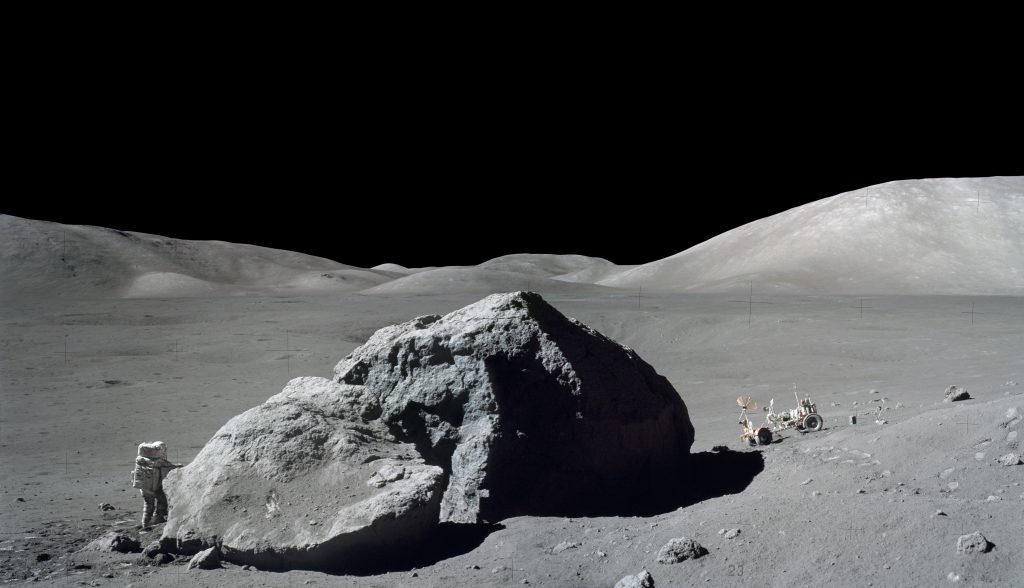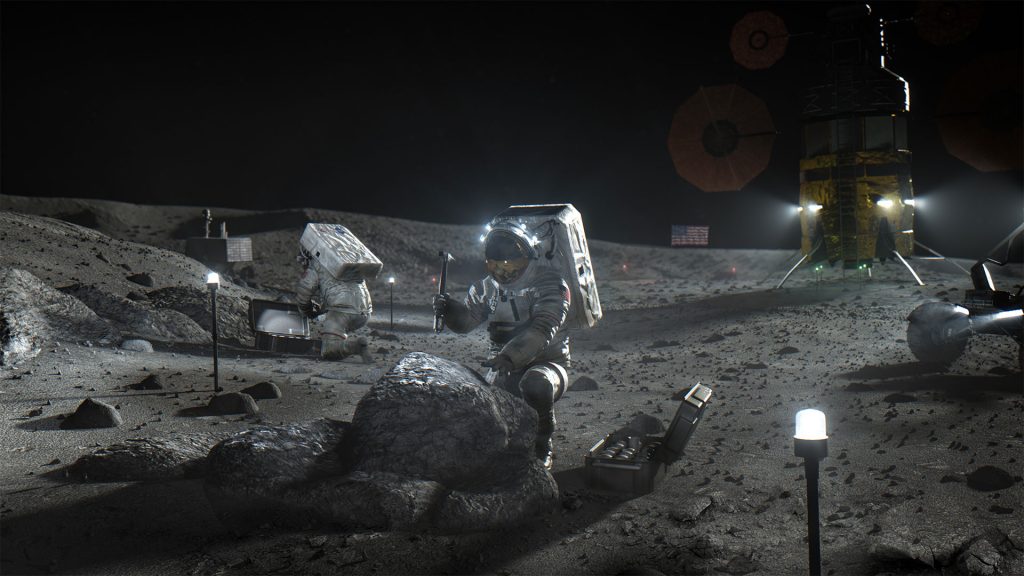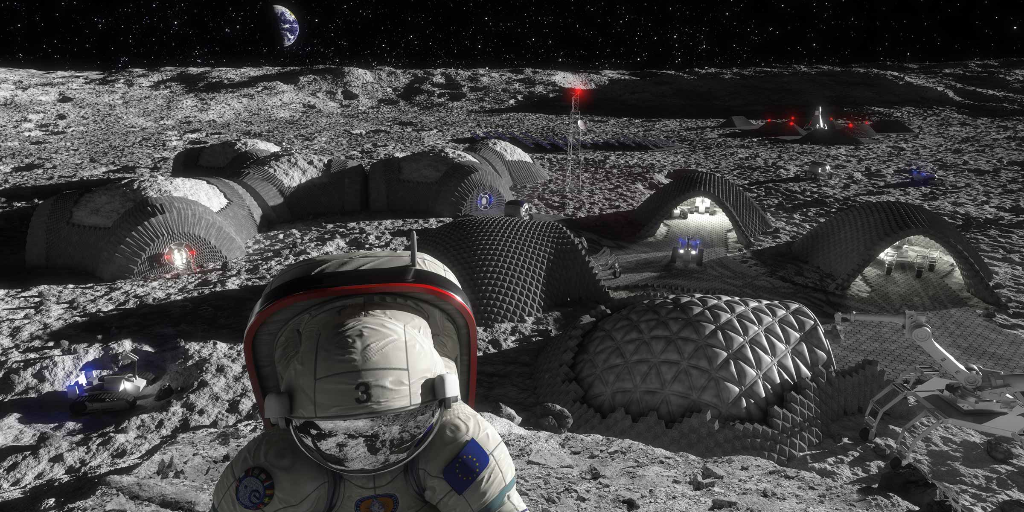What is Space Economy?
The in-space economy can be defined as the full range of activities and the use of resources that benefit human beings by exploring, researching, managing, and utilizing space. It is a modern concept and will revolutionize the world with a new economy based on space systems and applications. Private companies will actively participate and invest with the expectation of producing economic and social benefits.
Economic and Societal Benefits of Space Infrastructure
The space economy is growing and evolving, together with the development and profound transformation of the space sector and the further integration of space into society and economy. Today, the deployed space infrastructure makes new services possible, enabling new applications in industries such as meteorology, energy, telecommunications, insurance, transport, maritime, aviation, and urban development leading to additional economic and societal benefits. The space sector is a growth sector itself but is the vital enabler of growth in other sectors. The currently available space-based technologies for Earth observation have countless benefits to the business in multiple sectors.
Who is Involved in the Space Industry?
The space industry includes all kinds of actors involved in space exploration, including public and private institutions. It has military and defense institutes, commercial enterprises, space services providers, Earth monitoring and telecommunications, and all kinds of resources capable of adding value to human lives and society. All sorts of public and private actors from research development to space infrastructure (e.g. Earth stations, launch vehicles, and satellites) and developing, providing, and using space products and services (navigation devices, satellite phones, meteorological services, etc.). The space economy has gone beyond the space industry itself in as much as space products; space services enhance the effects of (quantitative and qualitative) know-how on society and the economy.
Why the Moon is the Best Choice?
Nowadays, there is growing competition in the space sector on a corporate scale. It has a huge financial growth tendency. Space resource utilization is an important aspect of sustainable human presence. In the future, emerging space industries might be transformed into a major part of space tourism and resource reacquisition (on planets, the Moon, and asteroids). The Moon, despite all the differences, still bears a resemblance to Earth when compared to other accessible surfaces in our solar system. The road to Mars and the exploration of space leads through the Moon. It is the next logical step in the human exploration of space. The Moon is the logical proving ground for subsequent industrial developments and settlements elsewhere. Only 2-3 flight days away, it allows us to develop at our very doorstep the experience we need to operate successfully and cost-effectively in more distant regions. No other celestial body and no orbiting space station can more effectively permit the development of the habitats, material extraction and processing methods, and in essence, all the science, technology, and sociology required for a responsible approach to extraterrestrial operations.
The Moon is an ideal “staging post” to accumulate materials and workforce outside of the Earth’s deep gravitational well. From the Moon, we can send missions into deep space and ferry colonists to Mars. Tourists may also be interested in a short visit. Mining companies will no doubt want to set up camp there. For a large number of reasons, we will need to build a Moon base to colonize the Moon. The return to the Moon can best be accomplished by taking advantage of government and industry partnerships and international cooperation.

Credit: NASA/Eugene Cernan
Private Sector Involvement in Space and its Commercialisation
The space economy is accelerating. Over 80% of the rapidly growing billion dollars global space economy is commercial. In 2020, the commercial space industry shattered records by launching over 1,000 spacecraft to orbit. Reusable launch vehicles, 3D printing in space, and in-space refueling are just a few of the developments that have emerged from a diverse community of space entrepreneurs.
Many space-based activities have commercial potential. For example:
- tapping space-based clean energy sources,
- mining asteroids for useful raw materials,
- developing safe venues for scientific experiments,
- upcycling/sequestering hazardous but valuable debris currently in space,
- tapping sources of water already in space, to decouple into oxygen and hydrogen for space fuels and oxidizers, and to provide radiation shielding mass,
- using the low-gravity, low-temperature, and other properties of space for many activities, including manufacturing and research.
These endeavors and our current use of space for communication, navigation, defense, etc., argue for a change in our approach to space from the current exploration paradigm to commercialization. Transportation infrastructure will create the environment for private players to develop space-based industries that use commerce to increase life quality and decrease living costs significantly. The history of developing frontiers, such as the open seas via shipping practices and the American West via railroads, demonstrates this evolution’s effects in the public role. Private sector launch allows the market to exploit every available efficiency to develop the cheapest, most effective means of space travel.
The Future of Space Commercialization
Commercialization is fueling our advances in space activities. The application of sensible business practices and efficiencies like reusable rocket boosters has lowered the cost and increased the availability of launches for new space missions. The revolution in small satellite technology allows for much greater innovation and flexibility in developing new space architectures. Developments in related technology areas are dramatically increasing throughput for communications satellites and enabling an explosion in the volume and diversity of remote sensing information and other space-based data. Advances in artificial intelligence and data management can use space-based data to help us make better decisions here on Earth. We continue to leverage the unique contributions of past space investments as we navigate the COVID-19 pandemic through virtual webinars, telemedicine, and distance learning.
Novel missions like space tugs, commercial space stations, and on-orbit servicing manufacturing and debris removal are likely to happen or appear soon. Scientists and entrepreneurs are experimenting with how to grow food in space and mitigate the harsh effects of the space environment on the human body. Right now, we are developing the infrastructure needed to support the next wave of space exploration, from deep space communications to housing and training the first generation of pioneers who will live sustainably on the Moon.
Additionally, the advent of satellite servicing revolutionizes the economics of space. The first of Northrop Grumman’s Mission Extension Vehicles has already breathed a Lunar Economy additional five years of life into an aging Intelsat satellite, and the second is on its way to serve as a fuel source and engine for another. Companies are pursuing additional capabilities from satellite inspection to on-orbit assembly and manufacturing. OrbitFab’s first satellite refueling tanker is scheduled for launch in 2021, signaling a key technology maturation for interplanetary travel. Beyond the obvious technical benefits, these developments will help sharpen the business cases that encourage private investment and enable a truly sustainable human presence in space.
China’s successful lunar landings and Japan’s impressive return of a sample from the asteroid Ryugu are part of the new race to leverage space’s economic potential, with even higher stakes. Private companies, investors, and over 70 nations place huge bets on space technology to reap economic and security benefits. Competition is increasing, especially between Western countries and China.
Space Resource Utilisation
Space Resource Utilisation (SRU; also known as In Situ Resource Utilization (ISRU)) will be an important aspect of a sustainable human presence off the Earth, initially at the Moon and Mars. The use of local resources is a way to decouple activities away from Earth and from the costs associated with the need to launch supplies from Earth’s deep gravity well. Structures, consumables, energy, parts, and equipment may at some point be produced, entirely or in part, from space materials sourced on-site or from a nearby extraterrestrial body, to reduce cost and allow adaptability and flexibility for exploration architectures and scenarios.

This change of paradigm, to implement production at the point of need from local materials, can make space exploration sustainable in the long term. It could be perceived that SRU is a recent innovation that is only now gaining recognition. However, while a resurgence of international interest in the subject occurs, the area has a long heritage marked by rises and falls in activity aligned with political drives to explore and advance human presence in space. In preparing for the future, it is essential to understand what has come before, the successes, failures, and lessons of past attempts to access and utilize the resources of space. Feasibility costs are based on various factors, such as future regulations, international affairs, and technological developments.
US National Space Policy 2020
The United States has released its National Space Policy 2020, recognizing the importance of space commerce. It supports Space commerce with Lunar economic development and innovation-driven entrepreneurship. The policy goals of establishing a permanent human presence on the Moon while enabling dynamic science and commercial opportunities, including space resource utilization.
The policy makes some updates explicitly in support of space commerce:
- Directs the government to partner with the commercial space industry to gain innovation and cost savings;
- Calls for targeted investments to encourage commercial space innovation and entrepreneurship;
- Directs further regulatory streamlining to ensure timely, predictable, transparent, and flexible licensing processes that accommodate rapid innovation and adapt to market demands, consistent with Streamlining Regulations on Commercial Use of Space (Space Policy Directive-2 (SPD-2));
- Tasks the Commerce Department to develop a new process to review, authorize, and supervise space activities beyond the scope of existing federal authorizations;
- Reiterates the Commerce Department’s role as the lead civil agency for providing space situational awareness (SSA) and collision warnings to commercial space operators, consistent with National Space Traffic Management Policy (SPD-3);
- Underscores the need for responsible behavior in space (including use of SSA data and services), which is essential to safe, sustainable space commerce;
- Calls for government and industry collaboration to secure the IT infrastructure for space systems, consistent with Cybersecurity Principles for Space Systems (SPD-5); and
- Promotes the development of commercial habitats in Earth orbit to eventually replace the International Space Station.
Ethical Conduct in Lunar Commercialization
Countries from across the world are striving to explore and one day colonize the Moon. With the growing demand for natural resources to fuel intercontinental technological advances and reduce terrestrial sources, governments and industries are investing in space exploration missions. It is important to develop moral and ethical models for space commercialization, specifically as it relates to lunar settlements.
Environmental concern has an important question about changing the character of the lunar surface. The impact of construction, traffic, mining, and other human activities related to lunar settlement needs to be analyzed. A balanced approach between the classical environmental concern and corporate and commercial will prove to be a long-term evolutionary process.
Social scientists have proposed three guidelines to ethical conduct to lunar development that resembles a standard business code of conduct:
- Space Preservation – value space for its own sake regardless of potential benefits that can be derived from it,
- Space Conservation – protect and care for the universe’s resources for the sake of all,
- Space Stewardship – holding ourselves accountable for managing space resources.
By bringing economic development to the Moon and beyond for human benefits, the approach used to address environmental concerns should be one of the many focuses of the business code of conduct.
Lunar Economy and Development
The return of humans to the Moon needs the development of an evolvable, economical, and sustainable lunar surface infrastructure using a public-private partnership. A strong partnership between government and private industry is required to establish lunar surface infrastructure mutually. Support robotic missions initially and later evolve to full-scale commercial infrastructure services in support of human missions. These infrastructure services may range from power systems, communication and navigation systems, thermal management systems, mobility systems, water, and propellant production to life support systems for human habitats.
Companies around the world – in transportation, exploration, energy, construction, or hospitality – are all looking upwards for the next growth opportunity. Space is quickly becoming a place where the industries that power our global economy will conduct business, and these activities will most likely start from the commercialization of the Moon.
Colonization of the Moon
A private settlement on the Moon offers an opportunity to return to the Moon and a lunar outpost that is both feasible and cost-effective. Technology is not the issue, but rather economics. It proposes an approach that leverages the strengths of both private industry and private capital that supports and enhances both science and the exploration of the Moon. It is a return to the Moon that takes advantage of both new technologies and the new economics of the space age. It is an approach that harnesses the energy and resources of commerce while supporting a platform and destination to explore space.
International cooperation, as demonstrated by the International Space Station, has proven to be of great benefit. And a lunar settlement that utilizes the capabilities of commerce and other countries could not only prove to be of similar benefit but could well provide the foundation for the human exploration of space well beyond the lunar surface.
If conducted properly, the private settlement of the Moon and Solar System can expand the global economy and increase economic activities. As we have crossed the 50 years since the first Apollo landed on the Moon, technologies have advanced along with our understanding of the value and benefits of Lunar exploration. Indeed, the next steps on the Moon will take full advantage of the exponential revolution and digital renaissance. The use of robotics, cislunar (i.e. between the Earth and the Moon or the Moon’s orbit) cycler (i.e. cyclers, meaning spacecraft that continually cycle between orbiting bodies, approaching and departing them periodically, without ever stopping at them) architectures, and in-situ resources will be both logical and the key to the success of any settlements.
Telecommunications Sector Plays a Vital Role in Lunar Economy Development
Telecommunications has played a significant role in the development and advancement of humanity and is one of the key enabling capabilities that has fueled the rate and pace of growth. Today, telecommunications services are primarily a commercial endeavor, with a business model based on revenues, transitioning from the early days of being government or institutionally owned and operated. Taking the experience and lessons learned from growth on Earth, it is evident that telecommunications will play a critical role in the exploration, habitation, and settlement of the Moon. The success and rate of development are heavily dependent on the approach adopted and the corresponding infrastructure deployed. To implement a lunar economic action plan and facilitate the timely and cost-effective habitation of the Moon, it would be advantageous to establish a common telecommunications architecture or framework and encourage the commercial provision of telecommunications services.
Demand for Real-time Communication Services
During the initial exploration phase, activities will continue to be controlled and monitored from the Earth. The requirement to support these activities will be for near real-time command and control and payload data recovery, with processing done on the Earth in a non-real-time environment. There will be a growing requirement for communications relay capability to address the increased capacity requirements, provide increased coverage, and support missions. To improve the efficiency and cost-effectiveness of the exploration activities, it will be necessary to stop considering the missions in isolation and start supporting activities across multiple programs. Groups are considering, for example, the use of very small satellites and landers for further exploration, which cannot physically accommodate the equipment needed for direct to Earth communication and require the use of a lunar communications relay to provide connectivity to the Earth. Today the groups are struggling to bring their programs to fruition as the cost of implementing the lunar relay in addition to the experimental satellites and landers makes it prohibitive.
Technologies for Infrastructure Development and Its Impact on Commercial Activities
Developing a lunar economy will require a significant amount of infrastructure on the lunar surface. Humans will need to rely heavily on in situ resource utilization (ISRU) technologies to develop this infrastructure. One of the ISRU system’s primary requirements will be to provide construction materials to build habitats, storage bins, landing pads, roads, and other infrastructure.
The Moon also contains many resources that can be used for commercial purposes. One of the key technologies for harvesting these resources is the robotic mining of regolith, minerals, ices, and metals. The harsh environment and vast distances create challenges that are handled best by robotic machines working in collaboration with human explorers. Humans will benefit from the resources that will be mined by robots. They will visit outposts and mining camps as required for exploration, commerce, and scientific research, but a continuous presence is most likely to be provided by robotic mining machines remotely controlled by humans. These robots often have the same functions that are required for construction tasks. Excavation, hauling, and dumping are all examples of common capabilities required.
The terrestrial robotic mining technologies will have to be customized and adapted for use in space environments, but many parts, algorithms, and sub-systems can be used for leveraging an extraterrestrial mining industry. Examples include vision processing systems, LiDAR, sensors, harmonic drives, long-life bearings (bearing, meaning a part of a machine that supports another part that turns around), advanced mobility, microprocessors, end effectors (i.e. a device at the end of a robotic arm, designed to interact with the environment), human-machine interfaces (HMI; a user interface or dashboard that connects a person to a machine, system, or device), and operations methodologies.
One of the primary objectives of the lunar settlement is the utilization of lunar resources for societal benefits. The solar wind bombards the isotope Helium-3 towards the revolving bodies. The Earth’s magnetic field resists it, but it lands on the Moon and can be found on its surface. Scientists claim that this isotope can prove to be a very efficient fuel for fusion reactions, and its presence on the Moon is a lot more than on Earth. Research is going on in this area, and if it proves to be right, then the Moon’s surface would be highly beneficial for the energy sector. Scientists even claim that it has the potential to end the energy crisis forever. The Moon has abundant Helium-3, which proves to be an efficient fusion fuel for energy production without any radioactive wastes. This can lead towards the start of many lunar missions to mine the Moon’s surface for Helium-3 extraction. Governments and private companies both seem interested in this Moon mining for Helium-3, and maybe in the future, it can lead to high financial benefits and contribute a lot to the lunar economy.
Let’s take a look at some more industry sectors that will be the first to take advantage of lunar commerce:
Energy
Energy is one of the largest industries on Earth. Humans are prolific energy consumers, and soon the number of people in space will increase.
Jeff Bezos, the founder, and former CEO of Amazon anticipates that millions of people will be living and working in space in the coming decades. Bezos is so confident of this outcome that he is investing billions into his space transportation firm, Blue Origin. An in-space population of this magnitude will require enormous amounts of energy to live, work, and transit. This energy will come from solar power, which is more effective when gathered in space due to the lack of a filtering atmosphere, and chemical rockets, which will be the primary transport mechanism for the foreseeable future.
The most efficient chemical rocket propellants are composed of cryogenic liquid oxygen combined with liquid hydrogen or methane. Initially, the propellant needed to fuel the space economy will be launched from Earth. However, there is a much more attractive way to source the propellants needed to support a sustained human presence in space – mining it.
Mining
The global mining industry may change quickly once the global definition of mining is transformed by the emerging space resource industry.
Space resources can be extracted from celestial bodies, most notably asteroids and the Moon. The Government of Luxembourg believes so strongly in this emerging industry it recently initiated a program intending to establish Luxembourg as a European hub for space resources. It aims to contribute to the peaceful exploration and sustainable utilization of space resources to benefit humankind. Space mining activities will initially focus on water and water-derived propellants to enable in-space infrastructure. Once this propellant is readily available, companies will begin sourcing structural metals for construction projects and eventually precious metals needed for in-space manufacturing or possibly returning to Earth.
Transportation
Making propellants available beyond Earth’s gravitational influence will lead to creating the first in-space superhighway – a series of fuel depots placed in strategic locations throughout the solar system.
Imagine the growth potential of the energy, mining, and refining industries once they are freed from the constraints of an economy limited only to Earth. The in-space transportation and logistics firms that will consume these products are already well established and are headed by titans of industry: Elon Musk (SpaceX), Richard Branson (Virgin Galactic), Jeff Bezos (Blue Origin), and Tory Bruno (United Launch Alliance). The door is now open to in-space mining firms like Planetary Resources (backed by industrial giant Bechtel and the Government of Luxembourg) to capture this increasingly important market by providing water and water-based propellants to the space transportation industry.
Hospitality and Real Estate
Humans can only live, work, and play in space if they have shelter from space’s harsh environment.
Numerous commercial space station companies, including one created by billionaire hotel-chain-founder Robert Bigelow, compete for lucrative contracts that range from supporting sovereign astronauts and high-net-worth tourists to leasing space-in-space for orbital manufacturing and research and development programs. This new industry is anticipated to generate $37 billion in the next decade alone.
Space habitats will be launched from Earth initially, but as the resource supply chain expands and resources from the Moon become available, this sector will rely on resources sourced from space. Construction firms will gain the ability to create megastructures: hotels, factories, and permanent settlements that are no longer limited by size. The first cities on the Moon will become possible as markets for real estate. Space will become affordable and profitable for developers.
The concept of space tourism is one of the most exciting emerging features of the wider tourism industry, and companies like Virgin Galactic and SpaceX are already making waves by outlining plans to deliver various forms of commercial spaceflight in the near future. It is expected that several private companies will most likely start taking humans to space, most likely in the next decade.
Conclusion
The future looks to be an exciting place with settlements on the Moon and beyond. It will expand the economy here on Earth. A feasible and sustainable lunar ISRU through commercialization can happen when affordable transportation and energy resources are available. Successful lunar ISRU will lead to ISRU on asteroids and Mars and beyond, resulting in human migration to other celestial bodies. Infrastructure for the Moon in the coming years: particularly for scientific exploration, settlement, and mining needs investment from the private sector, especially while the state of the lunar colony is in its embryonic stage.
Robotics and telecommunications play a vital role in the development of lunar infrastructure and will be among those sectors that will benefit the most and contribute to the economy. Investment in these areas and other advanced technologies directed towards space mineral exploitation, excavation, and adequate transportation is necessary. A legal framework should be formed so that governments and private enterprises can begin to think about establishing controls on space businesses. This system’s centerpiece must include moral and ethical codes of behavior for those living and working on celestial bodies in the future.

